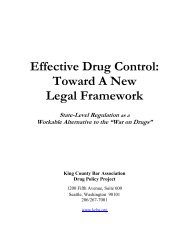RACE AND THE ENFORCEMENT OF DRUG DELIVERY LAWS IN ...
RACE AND THE ENFORCEMENT OF DRUG DELIVERY LAWS IN ...
RACE AND THE ENFORCEMENT OF DRUG DELIVERY LAWS IN ...
Create successful ePaper yourself
Turn your PDF publications into a flip-book with our unique Google optimized e-Paper software.
who used a serious illicit drug in the past month were white. 52 In either case,<br />
these data indicate that a clear majority of those who recently used a serious<br />
illegal drug from 2002 to 2006 were white.<br />
Although useful, most general surveys such as those described above miss<br />
institutionalized, transient and homeless populations. As a result, such surveys<br />
may underestimate the prevalence of some categories of drug use. 53 In particular,<br />
the percentage of Seattle residents reporting heroin use in the previous year in<br />
the SAMHSA survey was very low (.1 percent). Yet, according to public health<br />
officials, 15,000–18,000 King County residents are injection drug users (IDUs),<br />
most of whom use heroin. 54 In the Seattle-King County area, concern among<br />
public health officials has therefore centered on injection drug use, which is<br />
believed to be unusually prevalent and poses particular health risks. 55 The<br />
Seattle-King County Needle Exchange Survey is an important source of<br />
information about IDUs living in King County.<br />
2007–2008 SEATTLE-K<strong>IN</strong>G COUNTY NEEDLE EXCHANGE SURVEY<br />
The 2007-2008 Seattle-King County Needle Exchange Survey was conducted on<br />
behalf of Public Health - Seattle & King County and The Defender Association. 56<br />
The survey was administered at all seven needle exchange sites in Seattle-King<br />
County during all hours of operation for a two-week period of time (September<br />
11–24th, 2006). Only clients who exchanged needles were surveyed. The twoweek<br />
sampling period was selected because according to public health experts,<br />
the majority of needle exchangers utilize the needle exchange services within that<br />
time frame.<br />
52<br />
These calculations were based on 2000 U.S. Census Bureau population counts provided in<br />
Tables QT-P6, P12, and P121; half of those in the 10–14 age range were combined with younger<br />
residents and subtracted from general population figures to calculate the proportion of the<br />
resident population and white resident population aged 12 and older.<br />
53 For example, a survey of homeless Seattle youth (whose drug use patterns may or may not be<br />
similar to those found among homeless adults) found that 46 percent had used LSD, 33.5<br />
percent had used amphetamines, 18.1 percent had used (an unspecified form of) cocaine, and<br />
10.3 percent had used heroin in the past three months (Wagner et al. 2001).<br />
54 Banta-Green et al. 2006: 10; Deibert et al. 2006: 1347; Public Health- Seattle & King County<br />
2005.<br />
55<br />
Injection drug use poses serious and particular health risks. For example, roughly one-third of<br />
all new HIV cases and 60 percent of hepatitis C infections stem from injection drug use (Deibert<br />
et al. 2006: 1347; Lee and Sharpe 2003).<br />
56 The 2007-2008 Seattle-King County Needle Exchange Survey was designed by Michael<br />
Hanrahan, Kris Nyrop and K. Beckett.<br />
25

















